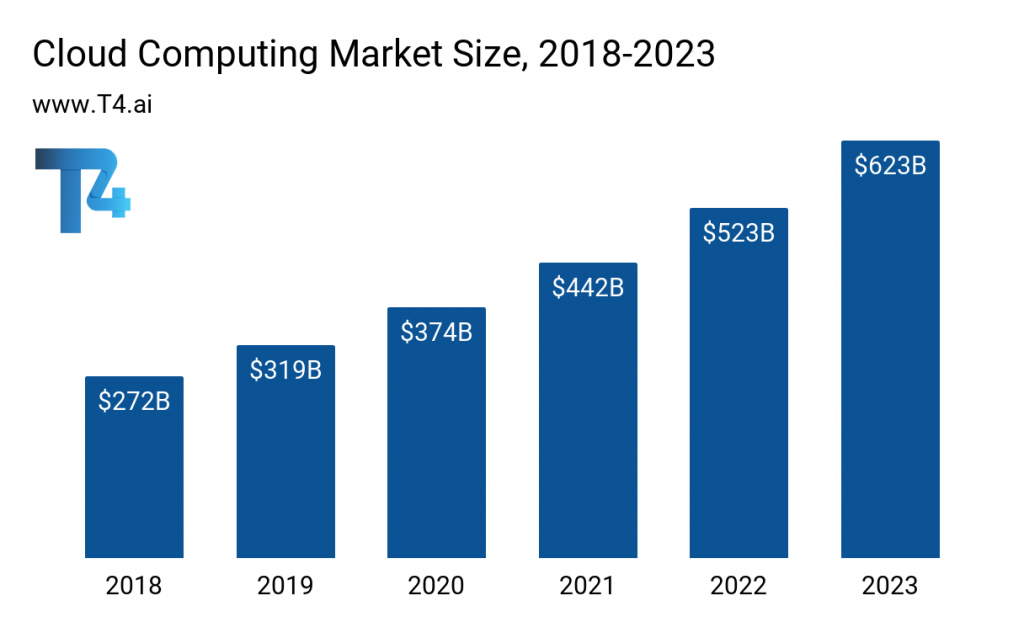To sign up for our daily email newsletter, CLICK HERE
2020 was a tough year for all of us, and its events will probably have an impact on the upcoming years, too. Many industries were struck pretty hard, but some of them came out of this with a profit. One of such sectors is the Cloud market, which noted unprecedented growth during the past few years. The pandemic didn’t have that much of an impact on the Cloud industry, although it has stunted its growth to a certain degree. Still, the market is projected to reach $305 billion from the current $257.5 billion—almost three times the increase in 2020, which equalled $14.8 billion.
2021 brings new challenges, but also new possibilities for the Cloud market. This, in turn, causes some major trends to emerge. Here are some of the most prominent ones for 2021.
Accelerated growth
Cloud doesn’t stop growing. In fact, its development is speeding up. Since many businesses are forced to function in a remote environment, a large number of them have decided to adopt Cloud services to be able to operate normally. Numerous companies that were indecisive about digital transformation have now acknowledged the benefits of migrating to Cloud since the pandemic further substantiated them.
Cost efficiency, scalability, and flexibility are the primary driving characteristics of the industry’s growth. Growing remote work trend corresponds with Cloud development, too. Seeing that it’s such a great facilitator of business processes and workflows, there’s no wonder it’s projected to snowball. Researchers foresee that the revenue generated by public Cloud services industry will reach $362.2 billion.
As for cloud computing, here’s a chart that illustrates the projected growth:

Multicloud
Involving the use of multiple Cloud providers’ services, Multicloud is quickly becoming a staple solution for many companies. Multicloud allows having the best of both worlds, without needing to stick to a single provider. Seeing that different suppliers have divergent strengths, multicloud lets you combine them to achieve better results. Cost efficiency is another factor of multicloud’s popularity. Using only the best features of a particular platform lets you better optimize the costs.
A collaboration between Microsoft and Oracle has been established, creating new possibilities of interconnecting the two platforms. This facilitation of multi-cloud done by the two corporations made using this solution much easier. Again, this enables customers to take the advantage of both providers’ strengths. You can learn about Oracle Cloud through Oracle Cloud Community. This community has active developers who have got you covered. You can learn from scratch and go on to master it.
Edge computing
Edge computing power lays mainly in its speed. Since the information doesn’t have to travel to the central server to be analysed and utilised, the latency is reduced to a great degree. It involves acquiring the data from smaller, local servers, contrary to your regular public Cloud. Applications developed via edge computing are faster, more responsive, and provide better real-time operating possibilities. The deployment of applications becomes quicker, too. Edge also enables firms to close the gap between the Cloud and local end-users.
Virtual desktops
The management of remote workers becomes far easier with Cloud. Interconnecting them with Desktop as a Service solutions lets you integrate their workspaces with one another. Since work from home trend is far from slowing down, this might become a viable option for corporations. For instance, call centres and the customer service industry are in a tough spot right now, as many businesses decided to switch to remote work, which makes employee management harder. These Cloud workspace platforms will let managers do their job seamlessly.
More cloud-native applications
Seeing that Kubernetes is a major success, more and more companies choose to build cloud-native applications using the system. Such apps provide much more flexibility, scalability, and power. Adaptation to the ever-changing industry trends becomes far more convenient with cloud-native. The popularity and fast development of open-source software is another consequence of switching to cloud-native.
Still, security keeps being a concern, as these cloud-native applications are fairly young. No definite standards have yet been adopted for companies. With the regulations being as rigorous as ever, this issue will need to be addressed as quickly as possible to ensure proper functioning.
Cloud-native also has the potential to change IT to a great degree. Platform and Cloud security architects will change due to the difference of cloud-native apps to the regular ones. The approach is largely contrasting, and so companies will prefer employees with open-source experience, and software-defined infrastructure.
Further growth of AI

With AI being increasingly popular in today’s technology, Cloud is becoming a go-to solution for the facilitation of Artificial Intelligence system development. The infrastructure that Cloud providers supply lets companies develop their applications freely and at a low cost. Most of the time, AI projects don’t go out of the planning and prototype stage. They simply become too expensive, complicated, and unscalable. Cloud computing technology makes AI DevOps, DataOps, and machine learning much more viable.
Serverless model
Serverless computing has so many advantages that we might see our development processes, adjusting to the model. It sets a new paradigm for Cloud computing. Seeing that you don’t need infrastructure knowledge for developing applications with serverless computing, it’s quickly becoming one of the major trends. It’s simpler, more flexible, and more comfortable. Function as a Service (FaaS) platforms allow developers to create the applications freely, without the need to worry about infrastructure management.
Wrap-up
Due to the fact that Cloud is such a rapidly-developing industry, it’s hard to predict the exact directions it will go in the following years. Still, we’re able to foresee numerous trends for the next year or so. Adaptation becomes the focal point of many businesses, as the market is changing rather frequently. We can be positive as to whether Cloud industry will keep growing—this is set in stone. The benefits very much outweigh the disadvantages.